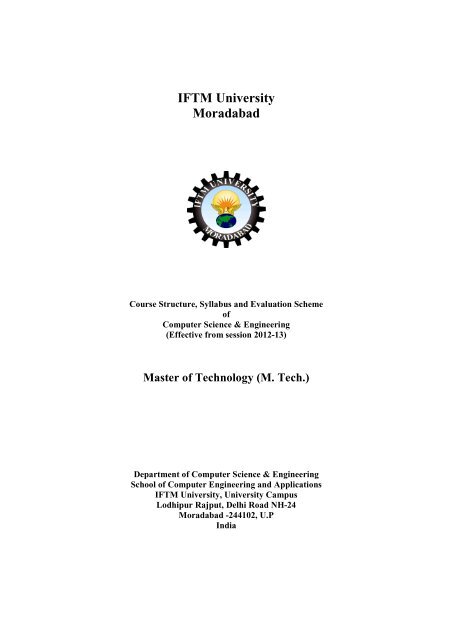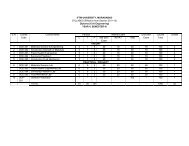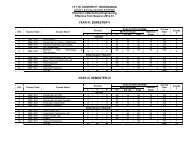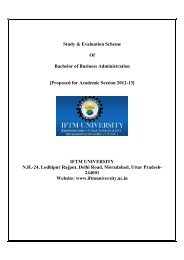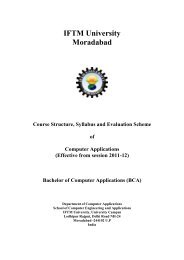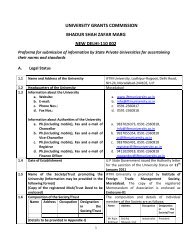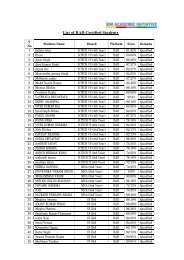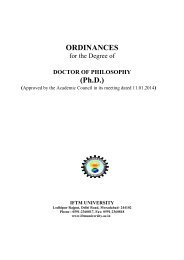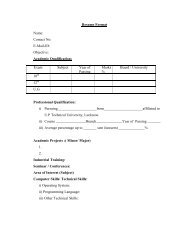IFTM University Moradabad
IFTM University Moradabad
IFTM University Moradabad
Create successful ePaper yourself
Turn your PDF publications into a flip-book with our unique Google optimized e-Paper software.
YEAR: I SEMESTER: IS.No Course SUBJECT PERIODS SESSIONAL ESE TOTAL CREDITSL T P TA AT CT Total1. MCS101 Advanced Distributed System 3 0 0 5 5 10+10 30 70 100 42. MCS102(A) Elective –I 3 1 0 5 5 10+10 30 70 100 43. MCS103 Advanced Computer Architecture 3 1 0 5 5 10+10 30 70 100 44. MCS104 Foundation in Computer Science 3 1 0 5 5 10+10 30 70 100 4PRACTICALS/Seminar/Projects5. MCS155 Computer System Lab-1 0 0 2 10 10 30 50 50 100 2500 18YEAR: I SEMESTER: IIS.No Course SUBJECT PERIODS SESSIONAL ESE TOTAL CREL T P TA AT CT TotalDITS1. MCS201 Advanced Computer Networks 3 1 0 5 5 10+10 30 70 100 42. MCS202 Machine Vision and Image Processing 3 1 0 5 5 10+10 30 70 100 43. MCS203 Soft Computing 3 1 0 5 5 10+10 30 70 100 44. MCS204(B) Elective-II 3 1 0 5 5 10+10 30 70 100 4PRACTICALS/Seminar/Projects5. MCS255 Computer System Lab-II 0 0 2 10 10 30 50 50 100 2500 18
Unit–IDISTRIBUTED SYSTEM (MCS101)L: T: P3 : 1 : 0Characterization of Distributed Systems: Introduction, Examples of distributed Systems, Resource sharingand the Web Challenges. System Models: Architectural models, Fundamental Models, Theoreticalfoundation for Distributed System: Limitation of Distributed system, absence of global clock, sharedmemory, Logical clocks, Lamport’s & vectors logical clocks, Causal ordering of messages, global state,termination detection. Distributed Mutual Exclusion: Classification of distributed mutual exclusion,requirement of mutual exclusion theorem, Token based and non token based algorithms, performance metricfor distributed mutual exclusion algorithms.Unit–IIDistributed Deadlock Detection: system model, resource Vs communication deadlocks, deadlock prevention,avoidance, detection & resolution, centralized dead lock detection, distributed dead lock detection, pathpushing algorithms, edge chasing algorithms. Agreement Protocols: Introduction, System models,classification of Agreement Problem, Byzantine agreement problem, Consensus problem, Interactiveconsistency Problem, Solution to Byzantine Agreement problem, Application of Agreement problem,Atomic Commit in Distributed Database system.Unit–IIIDistributed Objects and Remote Invocation: Communication between distributed objects, Remote procedurecall, Events and notifications. Security: Overview of security techniques, Cryptographic algorithms, Digitalsignatures Cryptography pragmatics, Case studies: Needham Schroeder, Kerberos, SSL & Millicent.Distributed File Systems: File service architecture, Sun Network File System, The Andrew File System andrecent advances.Unit–IVTransactions and Concurrency Control: Transactions, Nested transactions, Locks, Optimistic Concurrencycontrol, Timestamp ordering, Comparison of methods for concurrency control. Distributed Transactions: Flatand nested distributed transactions, Atomic Commit protocols, Concurrency control in distributedtransactions, Distributed deadlocks, Transaction recovery. Replication: System model and groupcommunication, Fault -tolerant services, highly available services, Transactions with replicated data.Unit–VDistributed Algorithms: Introduction to communication protocols, Balanced sliding window protocol,Routing algorithms, Destination based routing, APP problem, Deadlock free Packet switching, Introductionto Wave & traversal algorithms, Election algorithm. Case Studies: CORBA and RMI.
References:1. Singhal & Shivaratri, "Advanced Concept in Operating Systems", McGraw Hill2. Coulouris, Dollimore, Kindberg, "Distributed System: Concepts and Design”,Pearson Ed.3. Gerald Tel, "Distributed Algorithms", Cambridge <strong>University</strong> PressUnit-I Parallel computer modelsADVANCED COMPUTER ARCHITECTURE (MCS103)L: T: P3:1:0The state of computing, Classification of parallel computers, Multiprocessors and multicomputers,Multivector and SIMD computers.Program and network properties: Conditions of parallelism, Data and resource Dependences, Hardwareand software parallelism, Program partitioning and scheduling, Grain Size and latency, Program flowmechanisms, Control flow versus data flow, Data flow Architecture, Demand driven mechanisms,Comparisons of flow mechanismsUnit II PipeliningLinear pipeline processor, nonlinear pipeline processor, Instruction pipeline Design, Mechanisms forinstruction pipelining, Dynamic instruction scheduling, Branch Handling techniques, branch prediction,Arithmetic Pipeline Design, Computer arithmetic principles, Static Arithmetic pipeline, Multifunctionalarithmetic pipelinesUnit III Arithmetic for computersSigned and unsigned Numbers, Addition and Subtraction, Multiplication, Division, Floating Point.CPU Performance and Its factors, Evaluating performance of CPU.Unit IV Memory HierarchyIntroduction, The basics of Cache, Measuring and Improving of Cache Performance, Virtual Memory,Common framework for memory hierarchiesUnit V Enterprise Memory subsystem ArchitectureEnterprise RAS Feature set: Machine check, hot add/remove, domain partitioning, memorymirroring/migration, patrol scrubbing, fault tolerant system.References:1. Kai Hwang, “Advanced computer architecture”; TMH. 20002. D. A. Patterson and J. L. Hennessey, “Computer organization and design”, Morgan Kaufmann, 2ndEd. 2002
MACHINE VISION AND IMAGE PROCESSING (MCS 202)L: T: P3:1:0Unit IDigital Image Fundamentals: - Digital image Representation – Functional Units of an Image processingsystem. Visual perception – Image Model _ Image sampling and Quantization – grayscale resolution – pixelrelationship – image geometry. Image Transforms – Unitary Transform, Discrete Fourier Transform,Cosine Transform, Sine Transform, Hadamard Transform, Slant and KL Transform.Unit IIImage Enhancement – Histogram processing – Spatial operations – Image smoothing –Image Sharpening –Color Image Processing methods- Color Image ModelsUnit IIIImage restoration and compression Degradation Model – Discrete Formulation – Circulant matrices –Constrained and Unconstrained restoration geometric transformations fundamentals – Compression Models– Error Free Compression – Lossy Compression – International Image Compression Standards.Unit IVImage Analysis and Computer Vision: Spatial feature Extraction – Transform feature –Edge detection-Boundary Representation-Region Representation-Moment Representation-Structure-Shape Features-Texture-Scene Matching and Detection-Image Segmentation-Classification techniques-Morphology-Interpolation.Unit VSensing 3D shape: how the 3rd dimension changes the problem. Stereo 3D description, 3Dmodel, matching,TINA. Direct 3D sensing-structured light, range finders, range image segmentation.Emerging IT applications: Recognition of characters, Fingerprints and faces-Image databases.References:1. Fundamentals of Digital Image Processing-A.K.Jain2. Image Processing and machine vision-Milan Sonka,Vaclav Hlavae3. Pattern Recognition Principles-J.T. Tou and R.C.Gonzalez4. Syntactic Pattern Recognition and applications.-King Sun Fun5. Computer vision-Fairhurst (PHI).6. Rafael C. Gonzalez & Richard E. Woods, “Digital Image Processing”, 2 nd Ed, Pearson Edu, 20047. A.K. Jain, “Fundamental of Digital Image Processing”, PHI. 2003
SOFT COMPUTING (MCS 203)L: T: P3:1:0Unit I Neural NetworksHistory, overview of biological Neuro-system, Mathematical Models of Neurons, ANN architecture,Learning rules, Learning Paradigms-Supervised, unsupervised and reinforcement Learning, ANN trainingAlgorithms-perceptions, Training rules, Delta, Back Propagation Algorithm, Multilayer Perceptron Model,Hopfield Networks, Associative Memories, Applications of Artificial Neural Networks.Unit II Fuzzy Logic:Introduction to Fuzzy Logic, Classical and Fuzzy Sets: Overview of Classical Sets, Membership Function,Fuzzy rule generation. Operations on Fuzzy Sets: Compliment, Intersections, Unions, Combinations ofOperations, Aggregation Operations.Unit III Fuzzy Arithmetic:Fuzzy Numbers, Linguistic Variables, Arithmetic Operations on Intervals & Numbers, Lattice of FuzzyNumbers, Fuzzy Equations. Fuzzy Logic: Classical Logic, Multivalued Logics, Fuzzy Propositions, FuzzyQualifiers,Uncertainty based Information: Information & Uncertainty, Nonspecificity of Fuzzy & Crisp Sets,Fuzziness of Fuzzy Sets.Unit IVIntroduction of Neuro-Fuzzy Systems: Architecture of Neuro Fuzzy Networks.Application of Fuzzy Logic: Medicine, Economics etc.Unit VGenetic Algorithm: An Overview, GA in problem solving, and Implementation of GAReferences:1. “Introduction to the Theory of Neural Computation”, Hertz J. Krogh, R.G. Palmer, Addison-Wesley,California, 1991.2. “Fuzzy Sets & Fuzzy Logic”, G.J. Klir & B. Yuan, PHI, 1995.3. “An Introduction to Genetic Algorithm”, Melanie Mitchell, PHI, 1998.4. “Soft computing and Intelligent System Design”, F. O. Karray and C. de Silva, Pearson, 2009.5. “Neural Networks-A Comprehensive Foundations”, Prentice-Hall International, New Jersey, 1999.6. “Neural Networks: Algorithms, Applications and Programming Techniques”, Freeman J.A. & D.M.Skapura, Addison Wesley, Reading, Mass, (1992).
Unit IElective IADVANCED ALGORITHM (MCS 102(1))L: T: P3:1:0Recurrences - Master Method, Probability, AVL Trees, Red-Black Trees, Augmenting Data StructuresUnit IIAmortized Analysis, Optimal Binary Search Trees, Priority Queues, Binomial Heaps, Fibonacci Heaps.Medians/SelectionUnit IIIGraph Algorithms Minimum Spanning Trees, Brief review of Prim, Kruskal’s Algorithm, Max-Flow/Bipartite Matching, Preflow-push methods, Vertex and edge connectivity, Depth-First Search,Biconnected ComponentsUnit IVString Matching, Knuth-Morris-Pratt Algorithm, Rabin-Karp Algorithm, Suffix Trees. Matrices: Strassen’sMatrix MultiplicationUnit VComputational Geometry, Intractability, Sample Intractable Problems, Complexity Classes, Reductions,Polynomial-Time Approximation, Parallel Algorithms/P-Completeness*References1. S. Baase, Computer Algorithms, Introduction to Design and Analysis, 2nd edition, Addison-Wesley, 1988.2. R.L. Graham, D.E. Knuth, and O. Patashnik. Concrete Mathematics, Addison-Wesley, 1989.3. D. Gusfield. Algorithms on Strings, Trees, and Sequences: Computer Science and Computational Biology,Cambridge <strong>University</strong> Press, 1997.4. D. Gusfield and R. Irving. The Stable Marriage Problem: Structure and Algorithms, MIT Press, 1989.5. E. Horowitz and S. Sahni. Fundamentals of Computer Algorithms, Computer Science Press, 1978.6. D.E. Knuth, The Art of Computer Programming, Vols. 1 and 3, Addison-Wesley7. Cormen, Leiserson, Rivest, Introduction to Algorithms, MIT Press, 1990.
COMPUTATIONAL GEOMETRY (MCS 102(2))L: T: P3:1:0Unit IConvex Hulls: construction in 2d and 3d, lower bounds, Triangulations: Polygon Triangulations,Representations, Point-set Triangulations and Planer Graphs.Unit IIVoronoi diagrams: construction and applications, variants, Delayney triangulations: Divide and conquer, flipand incremental algorithms, duality of Voronoi diagrams, min max angle properties.Unit IIIGeometric Searching: point-location, fractional cascading, linear programming with prune and search, fingertrees, concatenable queues, segment trees, interval trees, Visibility: algorithm for weak and strong visibility,visibility with reflections, art gallery problems.Unit IVArrangements of lines: arrangements of hyper planes, zone theorems, many-faces complexity andalgorithms, Combinatorial Geometry: Ham sandwich cuts.Unit VSweep Techniques: plane sweep for segment intersections, Fortune’s sweep for Voronoi diagrams, andtopological sweep for line arrangements, and randomization for computational Geometry: algorithms,techniques for counting, Robust geometric computing, Applications of computational geometry.References:1. France P. Preparata, Mical Ian Shamos, “Computational Geometry; An introduction” SpringerVerlag.2. Mark Berg, Mark Van Kreveld, Mark Overmars and Otfried Schwarzkopf, “ComputationalGeometry: Algorithms and Applications”, Springer.
Unit IPARALLEL ALGORITHMS (MCS 102(3))L: T: P3:1:0Sequential Models, need of alternative model, parallel computational models such as PRAM, LMCC,hypercube, Cube Connected Cycle, Butterfly, Perfect shuffle Computers, tree model, Pyramid model, FullyConnected model, PRAM_CREW, EREW Models, simulation of one model from another one.Unit IIPerformance measure of parallel algorithms, speed up and efficiency of PA, Cost-optimality, An example ofillustrate Cost optimal algorithms-such as summation, Min Max on various models.Unit IIIParallel sorting networks, Parallel merging algorithms on CREW/EREW/MCC, Parallel sorting networks onCREW/EREW/MCC, linear array.Unit IVParallel Searching Algorithms, K th element, Kth element in X+Y on PRAM, Parallel matrix transportationand Multiplication algorithm on PRAM, MCC, Vector matrix multiplication, Solution of linear Equation,Root Finding.Unit VGraph Algorithms: Connected Graph, Search and Traversal, Combinatorial Algorithms- Permutations andCombinations, Derangements.References:1. M J Quinn, “Designing efficient Algorithms for parallel Computer” by Mc Graw Hill.2. S.G. Akl, “Design and Analysis of Parallel algorithms”.3. S.G. Akl “Parallel sorting Algorithm” by Academic Press.
Unit I Review of Object OrientationElective IIOBJECT ORIENTED SOFTWARE MODELING (MCS 204(1))L: T: P3:1:0Class and objects, effect of inheritance on polymorphism and variable declarations, concepts that defineobject orientation.Unit II RequirementsDeveloping requirements, reviewing requirements, managing requirements, Difficultiesand risks in domain and requirement analysis, requirement documents, Case studies and discussion on theabove topics.Unit III Unified Modeling LanguagesVisual modeling with UML, Use case model- use case, actor, and roles, Modeling withclasses – association, multiplicity, generalization, process of creating class diagram – difficulties and risks increating class diagram. Modeling interaction and behavior – interaction diagrams, state diagram and activitydiagram, implementing classes based on interaction and state diagram- difficulties and risks in modelinginteractions and behavior.Unit IV Architecting and Designing SoftwareThe process of design, design principles, architectural patterns, design document, difficulties and risks indesign. Frameworks: reusable subsystem. Design patterns – Singleton, observer, adapter, Façade, proxy withexamples.Unit V Implementation, Usability, Testing and QualityMapping models to Code, Mapping Object Model to Database Schema Usability Principles- user interfacedesign evaluating user interfaces Testing and Quality – strategies, defects, test cases and test plan,inspections, quality assurance.References:1. Timothy C. Lethbridge, Robert Laganiere “Object-Oriented Software Engineering– A practical softwaredevelopment using UML and Java”, Tata McGraw-Hill, New Delhi.2. Mike O’Docherty “Object-Oriented Analysis & design – understanding system development with UML2.0”, John Wiley.3. Bernd Bruegge, “Object oriented software engineering”, Second Edition, Pearson Education.4. Stephan R. Schach, “Object oriented software engineering”, Tata McGraw Hill5. Booch, Jacobson, Rumbagh, “The UML user Guide”, Pearson Education6. Ali Bahrami, “Object Oriented System Development”, McGraw Hill.
7. David William Brown, “An Introduction to Object Oriented Analysis Objects and UML in Plain English”,2nf Edition, Wiley.Unit IGAME THEORY (MCS 204(2))L: T: P3:1:0Introduction to Non Co-operative Game Theory: Extensive Form Games, Strategic Form Games, PureStrategy Nash EquilibriumUnit IINon co-operative Game Theory (in detail), Mixed Strategies, Existence of Nash Equilibrium, Computationof Nash Equilibrium, Two Player Zero-Sum Games, Bayesian GamesUnit IIIMechanism Design: An Introduction, Dominant Strategy Implementation of Mechanisms, Vickrey-Clorke-Groves Mechanisms, Bayesian Implementation of Mechanisms, Revenue Equivalence Theorem, Design ofOptimal MechanismsUnit IVCooperative Game Theory, Correlated Strategies, Correlated Equilibria, The Two PersonUnit VBargaining Problem, Games in Coalitional Form, The Core Shapley Value, Other Solution Concepts for CooperativeGamesReferences:1. Roger B. Myerson. Game Theory: Analysis of Conflict. Harvard <strong>University</strong> Press, September 1997.2. Andreu Mas-Colell, Michael D. Whinston, and Jerry R. Green. Microeconomic Theory. Oxford <strong>University</strong>Press, New York, 1995.3. Martin J. Osborne, Ariel Rubinstein. A Course in Game Theory. The MIT Press, August 1994.4. Philip D. Straffin, Jr. Game Theory and Strategy. The Mathematical Association of America, January1993.5. Ken Binmore, Fun and Games: A Text On Game Theory, D. C. Heath & Company, 1992.6. Paul Klemperer, Auctions: Theory and Practice, The Toulouse Lectures in Economics, Princeton<strong>University</strong> Press, 2004.
Unit I IntroductionSYSTEM SECURITY (MCS 204(3))L: T: P3:1:0Classical security Techniques and Computer Network Security Concepts. Confidentiality and Security,Security Policy and Operations Life Cycle, Security System Development and OperationsUnit II Secure Networking ThreatsThe Attack Process. Attacker Types. Vulnerability Types. Attack Results. Attack Taxonomy. Threats toSecurity: Physical security, Biometric systems, monitoring controls, and Data security and intrusion anddetection systems.Encryption TechniquesConventional techniques, Modern techniques, DES, DES chaining, Triple DES, RSA algorithm, Keymanagement. Message Authentication and Hash Algorithm, Authentication requirements and functionssecure Hash Algorithm, Message digest algorithm, digital signatures. AES Algorithms.Unit III Designing Secure NetworksComponents of a Hardening Strategy. Network Devices. Host Operating Systems. Applications. Appliance-Based Network Services. Rogue Device Detection, Network Security Technologies The Difficulties ofSecure Networking. Security Technologies. Emerging Security Technologies General DesignConsiderations, Layer 2 Security Considerations. IP Addressing Design Considerations. ICMP DesignConsiderations. Routing Considerations. Transport Protocol Design ConsiderationsUnit IV Network Security Platform OptionsNetwork Security Platform Options. Network Security Device Best Practices, Common Application DesignConsiderations. E-Mail. DNS. HTTP/HTTPS. FTP. Instant Messaging.IPsec VPN Design ConsiderationsVPN Basics. Types of IPsec VPNs. IPsec Modes of Operation and Security Options. TopologyConsiderations. Design Considerations. Site-to-Site Deployment Examples.Unit V Secure Network Management and Network Security ManagementOrganizational Realities. Protocol Capabilities. Tool Capabilities. Secure Management Design Options.Network Security Management, Firewalls, Trusted systems, IT act and cyber laws.References:1. Sean Convery, “ Network Security Architectures, Published by Cisco Press, First Ed. 20042. William Stalling “Cryptography and Network Security” Fourth Ed., Prentice Hall, 20063. Charles P. Pfleeger, Shari Lawrence Pfleeger, “Security in Computing” 3 rd Edition, Prentice Hall, 20034. Jeff Crume “Inside Internet Security” Addison Wesley, 2003
Unit-IElective IIIDATA MINING AND WAREHOUSING (MCS 301(1))L: T: P3:1:0Data Warehousing: Overview, Definition, Delivery Process, Difference between Database System and DataWarehouse, Multi Dimensional Data Model, Data Cubes, Stars, Snow Flakes, Fact Constellations, Concepthierarchy, Process Architecture, 3 Tier Architecture, Data Marting.Unit-IIAggregation, Historical information, Query Facility, OLAP function and Tools. OLAP Servers, ROLAP,MOLAP, HOLAP, Data Mining interface, Security, Backup and Recovery, Tuning Data Warehouse, TestingData Warehouse.Unit-IIIOverview, Motivation (for Data Mining),Data Mining-Definition & Functionalities, Data Processing, Formof Data Preprocessing, Data Cleaning: Missing Values, Noisy Data, (Binning, Clustering, Regression,Computer and Human inspection), Inconsistent Data, Data Integration and Transformation. Data Reduction:-Data Cube Aggregation, Dimensionality reduction, Data Compression, Numerosity Reduction, Clustering,Discretization and Concept hierarchy generationUnit-IVConcept Description:- Definition, Data Generalization, Analytical Characterization, Analysis of attributerelevance, Mining Class comparisons, Statistical measures in large Databases.Measuring Central Tendency, Measuring Dispersion of Data, Graph Displays of Basic Statistical classDescription, Mining Association Rules in Large Databases, Association rule mining, mining Single-Dimensional Boolean Association rules from Transactional Databases– Apriori Algorithm, MiningMultilevel Association rules from Transaction Databases and Mining Multi-Dimensional Association rulesfrom Relational Databases.Unit-VClassification and Predictions: What is Classification & Prediction, Issues regarding Classification andprediction, Decision tree, Bayesian Classification, Classification by Back propagation, Multilayer feedforwardNeural Network, Back propagation Algorithm, Classification methods K-nearest neighborclassifiers, Genetic Algorithm.Cluster Analysis: Data types in cluster analysis, Categories of clustering methods, Partitioning methods.Hierarchical Clustering- CURE and Chameleon, Density Based Methods-DBSCAN, OPTICS, Grid BasedMethods- STING, CLIQUE, Model Based Method –Statistical Approach, Neural Network approach, OutlierAnalysis
References:1. M.H.Dunham,”Data Mining:Introductory and Advanced Topics” PearsonEducation2. Jiawei Han, Micheline Kamber, ”Data Mining Concepts & Techniques” Elsevier3. Sam Anahory, Dennis Murray, “Data Warehousing in the Real World : A Practical Guide for BuildingDecision Support Systems, Pearson Education4. Mallach,”Data Warehousing System”,McGraw –HillUnit INATURAL LANGUAGE PROCESSING (MCS 301(2))L: T: P3:1:0Introduction to NLP, Achievement and brief history, open problems, major goal, characteristic of Language,Language structure, Language analyzerUnit IIStudy of grammar and semantics Morphology, word formation, theory of semantics, componential theory ofmeaning, truth conditional theory of meaning, pragmatics and discourseUnit IIIMachine translation Introduction, problems of machine translation. Approaches, language Accesor, Structureof Anusaraka system.Unit IVLexical; functional grammar (LFG ) and Indian languages, Overview of LGF, LFG formalism, wellformedness conditions, computational aspects, CFG and Indian languages, functional specification, treeadjoining grammar.Unit VTagging (introduction), Estimating the Parameters of HMMs, the Forward-Backward Algorithm.Implementation Issues. The task of Tagging. Tag sets, Morphology, Lemmatization, Tagging methods.Manually designed Rules and Grammars. Statistical Methods (overview).References1. Natural language processing by Akshar Bhartati, Sangal and Chaitanya, Eastern Economy Edition byPHI Learning.2. An introduction to Linguistics, language grammer and semantics by P Syal, and D.V.Jindal, EasternEconomy Edition, New Delhi: PHI, 2007.
INTELLIGENT SYSTEMS (MCS 301(3))L: T: P3:1:0Unit I Intelligent AgentsIntroduction, How agents should act, structure: Table-driven, Simple reflex, Goal-based, Utility-based,Agents that keep track of world, Environments.Unit II Problem FormulationProblem solving, formulating problems: Knowledge and problem types, Well-defined problems andsolutions, Measuring problem-solving performance, Choosing states and actions.Unit III Search MethodsSearching for solutions, Search strategies: Time, space, optimality and completeness issues. Un-informedsearch methods: Breadth-first, Depth-first, Iterative deepening, Bidirectional search, Avoiding repetitions,Constraint satisfaction search.Unit IV Informed search methods:Best first search: Greedy search, A*, Heuristic functions, Memory bounded search: IDA*, SMA*. Iterativeimprovement algorithms: Hill climbing, Simulated annealing, Application in CSPs.Unit V Uncertain Knowledge and ReasoningUncertainty, Probabilistic Reasoning Systems, Making simple decisions, Making complex decisions.Reasoning: Agents that reason logically, First-order logic, Inferences in 1st order logicReferences:1. Russell S., Norving P., “Artificial Intelligence – Modern Approach”2. Henry P., “Artificial Intelligence”, 3rd Ed., Winstone3. Patric H., “Lisp programming language”, Winstone
ELECTIVE – IVPROCESS ENGINEERING (MCS 302(1))L: T: P3:1:0Unit ISDLC in S/W and IS engineering, Relationship of SDLC to process models, Classical process models: Codeand fix, Waterfall, Prototype, Spiral, V, Fountain, Iterative and Incremental process models.Unit IIProcess meta-models: Zhy meta-models, limitations of classical models, Activity based models, IBIS,Contextual model, and Map model, Tracing, Backtracking, Guidance: passive, active.Unit IIIThe personal process and team process, Maturity models: the five levels of CMM, metrices to be collectedfor upward movements in levelsUnit IV:Introduction to ITIL, Six Sigma, ISO9000, Differences between these classes of problems handled by these.Unit VBusiness process models, business objects, relationships, roles, co-ordination activity, Workflow models,Formulating Business process models, Building situations specific business models, architecture,organization.References1. Pressmen. “Software Engineering”, Mcgraw-Hill2. Sommerville, “Software Engineering”, Pearson.3. Pfleegar, “Software Engineering Theory and Practice”, Pearson.
Unit IDIGITAL FORENSIC (MCS 302(2))L: T: P3:1:0Transform Methods: Fourier transformation, Fast Fourier Transformation, Discreet cosign Transformation,Mellin Fourier transformation, Wavelets, Split image in perceptual bands, Application of transformation inSteganography.Unit IIBiometrics: Overview of Biometrics, Biometric identification, Biometric Verification, Biometric Enrollment,Biometric system security.Authentication and Biometrics: Secure Authentication protocols, Access Control Security Services,Authentication Method’s, Authentication Protocols, Matching Biometric samples, Verification By Humans.Common Biometrics: Finger Print Recognition, Face recognition, Speaker Recognition, Iris Recognition,Hand Geometry, Signature Verification, Positive and Negative of Biometrics. Matching: Two kinds oferrors, Score distribution, Estimating Errors from Data, Error rate of match Engines, Definition of FAR andFRR.Unit IIIIntroduction to information hiding: Technical Steganography, Linguistic Steganography, Copy RightEnforcement, Wisdom From cryptography. Principals of Steganography:Framework for secretCommunication, Security of Steganography System, Information Hiding in Noisy Data, Adaptive VS nonAdaptive Algorithms, Active and malicious Attackers, Information Hiding in Written Text.Unit IVSurvey of Steganographic Techniques: Substitution System and Plane tools, Transform Domain Techniques:Spread spectrum and information hiding, Statistical Steganography, Distortion Techniques, CoverGeneration Techniques.Steganalysis: Looking for signatures: - Extracting hidden information, disabling hidden information.Unit VWatermarking and Copyright Protection: Basic Watermarking, Watermarking Applications, Requirementsand Algorithmic Design issues, Evaluation and Benchmarking of Watermarking system.References1. Katzendbisser, Petitcolas, “Information hiding Techniques for Steganography and digitalwatermarking”, Artech House.2. Peter Wayner, “Disappearing Cryptography: Information Hiding, Steganography and Watermarking2/e”, Elsevier.3. Bolle, Connell et. al. ,”Guide to Bioinformatics”, Springer.


